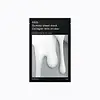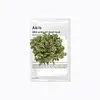What's inside
What's inside
 Key Ingredients
Key Ingredients

 Benefits
Benefits

 Concerns
Concerns

 Ingredients Side-by-side
Ingredients Side-by-side

Water
Skin ConditioningDipropylene Glycol
HumectantNiacinamide
SmoothingGlycerin
HumectantIsopentyldiol
HumectantCetearyl Ethylhexanoate
EmollientButylene Glycol
HumectantPolyglyceryl-3 Methylglucose Distearate
EmulsifyingPanthenol
Skin Conditioning1,2-Hexanediol
Skin ConditioningGlyceryl Stearate Se
EmulsifyingNeopentyl Glycol Diheptanoate
EmollientCarbomer
Emulsion StabilisingGlyceryl Caprylate
EmollientLactobacillus/Soymilk Ferment Filtrate
Skin ConditioningTromethamine
BufferingXanthan Gum
EmulsifyingEthylhexylglycerin
Skin ConditioningMethyl Glucose Sesquistearate
EmollientAdenosine
Skin ConditioningPaeonia Suffruticosa Root Extract
Skin ProtectingCentella Asiatica Extract
CleansingChamomilla Recutita Flower Extract
MaskingPantolactone
HumectantRosmarinus Officinalis Leaf Extract
AntimicrobialHydrogenated Lecithin
EmulsifyingAsiaticoside
AntioxidantAsiatic Acid
Skin ConditioningMadecassic Acid
Skin ConditioningPolyglyceryl-10 Laurate
Skin ConditioningCollagen Extract
Skin ConditioningTripeptide-1
Skin ConditioningCopper Tripeptide-1
Skin ConditioningAcetyl Tetrapeptide-5
HumectantAcetyl Tetrapeptide-2
Skin ConditioningPalmitoyl Pentapeptide-4
Skin ConditioningPalmitoyl Tripeptide-1
Skin ConditioningHexapeptide-9
Skin ConditioningHexapeptide-11
Skin ConditioningPalmitoyl Tripeptide-5
Skin ConditioningDisodium EDTA
Water, Dipropylene Glycol, Niacinamide, Glycerin, Isopentyldiol, Cetearyl Ethylhexanoate, Butylene Glycol, Polyglyceryl-3 Methylglucose Distearate, Panthenol, 1,2-Hexanediol, Glyceryl Stearate Se, Neopentyl Glycol Diheptanoate, Carbomer, Glyceryl Caprylate, Lactobacillus/Soymilk Ferment Filtrate, Tromethamine, Xanthan Gum, Ethylhexylglycerin, Methyl Glucose Sesquistearate, Adenosine, Paeonia Suffruticosa Root Extract, Centella Asiatica Extract, Chamomilla Recutita Flower Extract, Pantolactone, Rosmarinus Officinalis Leaf Extract, Hydrogenated Lecithin, Asiaticoside, Asiatic Acid, Madecassic Acid, Polyglyceryl-10 Laurate, Collagen Extract, Tripeptide-1, Copper Tripeptide-1, Acetyl Tetrapeptide-5, Acetyl Tetrapeptide-2, Palmitoyl Pentapeptide-4, Palmitoyl Tripeptide-1, Hexapeptide-9, Hexapeptide-11, Palmitoyl Tripeptide-5, Disodium EDTA
Water
Skin ConditioningGlycerin
HumectantDipropylene Glycol
HumectantAnastatica Hierochuntica Extract
AstringentPropanediol
SolventPentylene Glycol
Skin ConditioningChlorella Vulgaris Extract
Skin ConditioningPortulaca Oleracea Extract
Skin ConditioningLactobacillus Ferment
Skin ConditioningCynanchum Atratum Extract
Skin ConditioningAlthaea Rosea Flower Extract
Skin ConditioningSodium Hyaluronate
HumectantHydrolyzed Hyaluronic Acid
HumectantHyaluronic Acid
HumectantCamellia Sinensis Seed Oil
HumectantAvena Sativa Kernel Extract
AbrasiveYeast Ferment Extract
Skin ConditioningCocos Nucifera Oil
MaskingCamellia Oleifera Seed Oil
Skin ConditioningCandida Bombicola/Glucose/Methyl Rapeseedate Ferment
Antimicrobial1,2-Hexanediol
Skin ConditioningButylene Glycol
HumectantGlucose
HumectantFructooligosaccharides
HumectantFructose
HumectantPanthenol
Skin ConditioningDiphenyl Dimethicone
EmollientAllantoin
Skin ConditioningTriethylhexanoin
MaskingCaprylyl Glycol
EmollientPolyglyceryl-10 Laurate
Skin ConditioningTromethamine
BufferingEthylhexylglycerin
Skin ConditioningAdenosine
Skin ConditioningAmmonium Acryloyldimethyltaurate/Vp Copolymer
Dipotassium Glycyrrhizate
HumectantHydrogenated Lecithin
EmulsifyingSodium Phytate
Tocopherol
AntioxidantHydroxypropyltrimonium Hyaluronate
Sodium Acetylated Hyaluronate
HumectantHydrolyzed Sodium Hyaluronate
Skin ConditioningSodium Hyaluronate Crosspolymer
HumectantPotassium Hyaluronate
Skin ConditioningLecithin
EmollientCarbomer
Emulsion StabilisingCaffeine
Skin ConditioningXanthan Gum
EmulsifyingCetearyl Alcohol
EmollientWater, Glycerin, Dipropylene Glycol, Anastatica Hierochuntica Extract, Propanediol, Pentylene Glycol, Chlorella Vulgaris Extract, Portulaca Oleracea Extract, Lactobacillus Ferment, Cynanchum Atratum Extract, Althaea Rosea Flower Extract, Sodium Hyaluronate, Hydrolyzed Hyaluronic Acid, Hyaluronic Acid, Camellia Sinensis Seed Oil, Avena Sativa Kernel Extract, Yeast Ferment Extract, Cocos Nucifera Oil, Camellia Oleifera Seed Oil, Candida Bombicola/Glucose/Methyl Rapeseedate Ferment, 1,2-Hexanediol, Butylene Glycol, Glucose, Fructooligosaccharides, Fructose, Panthenol, Diphenyl Dimethicone, Allantoin, Triethylhexanoin, Caprylyl Glycol, Polyglyceryl-10 Laurate, Tromethamine, Ethylhexylglycerin, Adenosine, Ammonium Acryloyldimethyltaurate/Vp Copolymer, Dipotassium Glycyrrhizate, Hydrogenated Lecithin, Sodium Phytate, Tocopherol, Hydroxypropyltrimonium Hyaluronate, Sodium Acetylated Hyaluronate, Hydrolyzed Sodium Hyaluronate, Sodium Hyaluronate Crosspolymer, Potassium Hyaluronate, Lecithin, Carbomer, Caffeine, Xanthan Gum, Cetearyl Alcohol
 Reviews
Reviews

Ingredients Explained
These ingredients are found in both products.
Ingredients higher up in an ingredient list are typically present in a larger amount.
1,2-Hexanediol is a synthetic liquid and another multi-functional powerhouse.
It is a:
- Humectant, drawing moisture into the skin
- Emollient, helping to soften skin
- Solvent, dispersing and stabilizing formulas
- Preservative booster, enhancing the antimicrobial activity of other preservatives
Adenosine is in every living organism. It is one of four components in nucleic acids that helps store our DNA.
Adenosine has many benefits when used. These benefits include hydrating the skin, smoothing skin, and reducing wrinkles. Once applied, adenosine increases collagen production. It also helps with improving firmness and tissue repair.
Studies have found adenosine may also help with wound healing.
In skincare products, Adenosine is usually derived from yeast.
Learn more about AdenosineButylene Glycol (or BG) is used within cosmetic products for a few different reasons:
Overall, Butylene Glycol is a safe and well-rounded ingredient that works well with other ingredients.
Though this ingredient works well with most skin types, some people with sensitive skin may experience a reaction such as allergic rashes, closed comedones, or itchiness.
Learn more about Butylene GlycolCarbomer is a polymer of acrylic acid. Its main role is to create a gel consistency.
A high amount of carbomer can cause pilling or balling up of products. Don't worry, most products contain 1% or less of carbomer.
Dipropylene Glycol is a synthetically created humectant, stabilizer, and solvent.
This ingredient helps:
Dipropylene glycol is technically an alcohol, but it belongs to the glycol family (often considered part of the ‘good’ alcohols). This means it is hydrating and gentle on skin unlike drying solvent alcohols like denatured alcohol.
As a masking agent, Dipropylene Glycol can be used to cover the smell of other ingredients. However, it does not have a scent.
Studies show Dipropylene Glycol is considered safe to use in skincare.
Learn more about Dipropylene GlycolEthylhexylglycerin (we can't pronounce this either) is commonly used as a preservative and skin softener. It is derived from glyceryl.
You might see Ethylhexylglycerin often paired with other preservatives such as phenoxyethanol. Ethylhexylglycerin has been found to increase the effectiveness of these other preservatives.
Glycerin is already naturally found in your skin. It helps moisturize and protect your skin.
A study from 2016 found glycerin to be more effective as a humectant than AHAs and hyaluronic acid.
As a humectant, it helps the skin stay hydrated by pulling moisture to your skin. The low molecular weight of glycerin allows it to pull moisture into the deeper layers of your skin.
Hydrated skin improves your skin barrier; Your skin barrier helps protect against irritants and bacteria.
Glycerin has also been found to have antimicrobial and antiviral properties. Due to these properties, glycerin is often used in wound and burn treatments.
In cosmetics, glycerin is usually derived from plants such as soybean or palm. However, it can also be sourced from animals, such as tallow or animal fat.
This ingredient is organic, colorless, odorless, and non-toxic.
Glycerin is the name for this ingredient in American English. British English uses Glycerol/Glycerine.
Learn more about GlycerinHydrogenated Lecithin is created from the hydrogenation of lecithin (a group of phospholipids). Hydrogenation is a chemical reaction between hydrogen and another element.
This ingredient is an emollient and emulsifier. As an emollient, it helps soften skin by trapping moisture within. As an emulsifier, it prevents oil and water ingredients from separating.
Panthenol is a common ingredient that helps hydrate and soothe the skin. It is found naturally in our skin and hair.
There are two forms of panthenol: D and L.
D-panthenol is also known as dexpanthenol. Most cosmetics use dexpanthenol or a mixture of D and L-panthenol.
Panthenol is famous due to its ability to go deeper into the skin's layers. Using this ingredient has numerous pros (and no cons):
Like hyaluronic acid, panthenol is a humectant. Humectants are able to bind and hold large amounts of water to keep skin hydrated.
This ingredient works well for wound healing. It works by increasing tissue in the wound and helps close open wounds.
Once oxidized, panthenol converts to pantothenic acid. Panthothenic acid is found in all living cells.
This ingredient is also referred to as pro-vitamin B5.
Learn more about PanthenolPolyglyceryl-10 Laurate is an ester of lauric acid and Polyglycerin-10.
Polyglyceryl-10 Laurate is a cleansing agent and emulsifier. It helps gather dirt, oil, and other pollutants to be rinsed away. As an emulsifier, it helps prevent ingredients from separating, such as oil and water.
Polyglyceryl-10 Laurate may not be fungal acne safe.
Learn more about Polyglyceryl-10 LaurateTromethamine helps balance the pH and improve the texture of a product. It is synthetically created.
As an emulsifier, Tromethamine prevents oil and water ingredients from separating. This helps stabilize the product and elongate a product's shelf life. Tromethamine also makes a product thicker.
Tromethamine helps balance the pH level of a product. Normal pH level of skin is slightly acidic (~4.75-5.5). The acidity of our skin is maintained by our glands and skin biome. Being slightly acidic allows our skin to create an "acid mantle". This acid mantle is a thin barrier that protects our skin from bacteria and contaminants.
Oral Tromethanmine is an anti-inflammatory drug but plays the role of masking, adding fragrance, and/or balancing pH in skincare.
1,3-Propanediol, 2-amino-2-(hydroxymethyl)-
Learn more about TromethamineWater. It's the most common cosmetic ingredient of all. You'll usually see it at the top of ingredient lists, meaning that it makes up the largest part of the product.
So why is it so popular? Water most often acts as a solvent - this means that it helps dissolve other ingredients into the formulation.
You'll also recognize water as that liquid we all need to stay alive. If you see this, drink a glass of water. Stay hydrated!
Learn more about WaterXanthan gum is used as a stabilizer and thickener within cosmetic products. It helps give products a sticky, thick feeling - preventing them from being too runny.
On the technical side of things, xanthan gum is a polysaccharide - a combination consisting of multiple sugar molecules bonded together.
Xanthan gum is a pretty common and great ingredient. It is a natural, non-toxic, non-irritating ingredient that is also commonly used in food products.
Learn more about Xanthan Gum